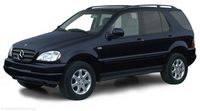New Car/Review
Mercedes Benz ML430 (2001)
SEE ALSO: Mercedes Buyer's Guide
By Matt/Bob Hagin
SPECIFICATIONS
Manufacturer's Suggested Retail Price $ 44,200
Price As Tested $ 45,330
Engine Type SOHC 24-valve 4.3 Liter V8 w/SMFI*
Engine Size 260 cid/4266 cc
Horsepower 268 @ 5500 RPM
Torque (lb-ft) 288 @ 4500 RPM
Wheelbase/Width/Length 111.0"/72.2"/180.6"
Transmission Five-speed automatic
Curb Weight 4871 pounds
Fuel Capacity 19.0 gallons
Tires (F/R) 275/55R17 mud & snow
Brakes (F/R) Disc (ABS)/disc (ABS)
Drive Train Front-engine/four-wheel-drive
Vehicle Type Five-passenger/five-door
Domestic Content N/A
Coefficient of Drag (Cd.) 0.39
PERFORMANCE
EPA Economy, miles per gallon
city/highway/average 16/20/18
0-60 MPH 8.0 seconds
Maximum cargo capacity 620 pounds
Maximum towing capacity 5000 pounds
* Sequential multi-port fuel injection
(Mercedes makes real "utility" vehicles like its Unimog for the home market, but they're not fancy like its M-Series SUVs, says Bob Hagin. Matt says Unimog wouldn't look right in a country club parking lot.)
MATT - Mercedes has never been known to compromise on its reputation for making high-class vehicles, and it's approach to building sport/utility vehicles is indicative of this corporate mind-set. Its ML-Series is built using a truck-based, body-on-chassis approach. And as far as I can tell, it was a ground-up design. But where most of its competitors operate with front-engine/rear-drive parameters and mount an archaic solid axle in back, the Mercedes version uses independent suspension at its tail. Because of this, and the way that Mercedes integrates the suspension with other systems, the Mercedes ML SUVs are as much at home cruising the highway as they are rolling along fire trails in search of good fishing spots.
BOB - Technically, the Mercedes SUVs are as advanced as the classy sedans and sports cars the company makes. There are basically two different engines available. The first, and least powerful, is a V6 that's used in the entry-level version, the ML320. At the top of the heap is a 5.5-liter V8 that's used in the ML55 AMG. The ML55 AMG is a 342-horse barnstormer that's good for 141 MPH and is more at home on the Autobahn in Germany than on the famous Rubicon Trail off-road course in Northern California. In the middle is the ML430, which uses the same V8 engine that's in the ML430 sedan that we played with for a week. As it's model number implies, its displacement is 4.2 liters, and while it's not a street-racer like the ML55, it nonetheless puts out 268 horsepower and 288 pound/feet of torque. This high torque makes it more suitable for rock-crawling than the ML55 or the ML320. None of them have a stick-shift available, even as an option, but the automatic does have a manual override system that lets the driver pretty much select the cog that's needed for the situation.
MATT - The ML-Series drivetrain is extremely sophisticated and can perform lots of tricks. When it's driven down a steep, loose, off-road trail, the driver can preset a downhill speed of 12 MPH or less and the vehicle will maintain it automatically. If it's being crawled over rocks and boulders with the transfer case in low range, the same kind of system will maintain a constant speed for the driver without having the jolts and jars of the terrain make it a jerky, wheel-spinning ride. The limit in that situation has to be around three MPH. In both cases, the anti-lock braking system and the traction control interact togteher and the transfer case has to be in low range.
BOB - Somehow I don't think that many of these luxury-liners are going to be used for crashing through the underbrush in pursuit of wild boar. Most of the time they'll find themselves cruising the highway providing typical Mercedes comfort for its crew and traveling in snow and on ice is probably the roughest duty they'll ever see. Our ML430 handled as well, if not better, in turns than many of the passenger sedans that we've tried. It had a minimal amount of lean and its handling was pretty close to neutral with maybe a bit of understeer to avoid problems.
MATT - Normally, it seats five but there's an optional third seat available for two more passengers. It's a bit difficult getting into that third one, but it's comfortable enough once the entry-gyrations are mastered. The ML-Series comes with a system that includes a panic button that will issue an SOS call for help and it works automatically if the driver's air bag deploys. If the driver doesn't respond when this thing goes off, it automatically dispatches an ambulance and the police. It also has a non-emergency button that calls for mechanical assistance from full-time Mercedes assistance operators. Now that's what I call service.
BOB - The only thing missing from the ML430 feature list is a full-time chauffeur, Matt, and it's just possible that the Mercedes customer-development people have that on the drawing board.



